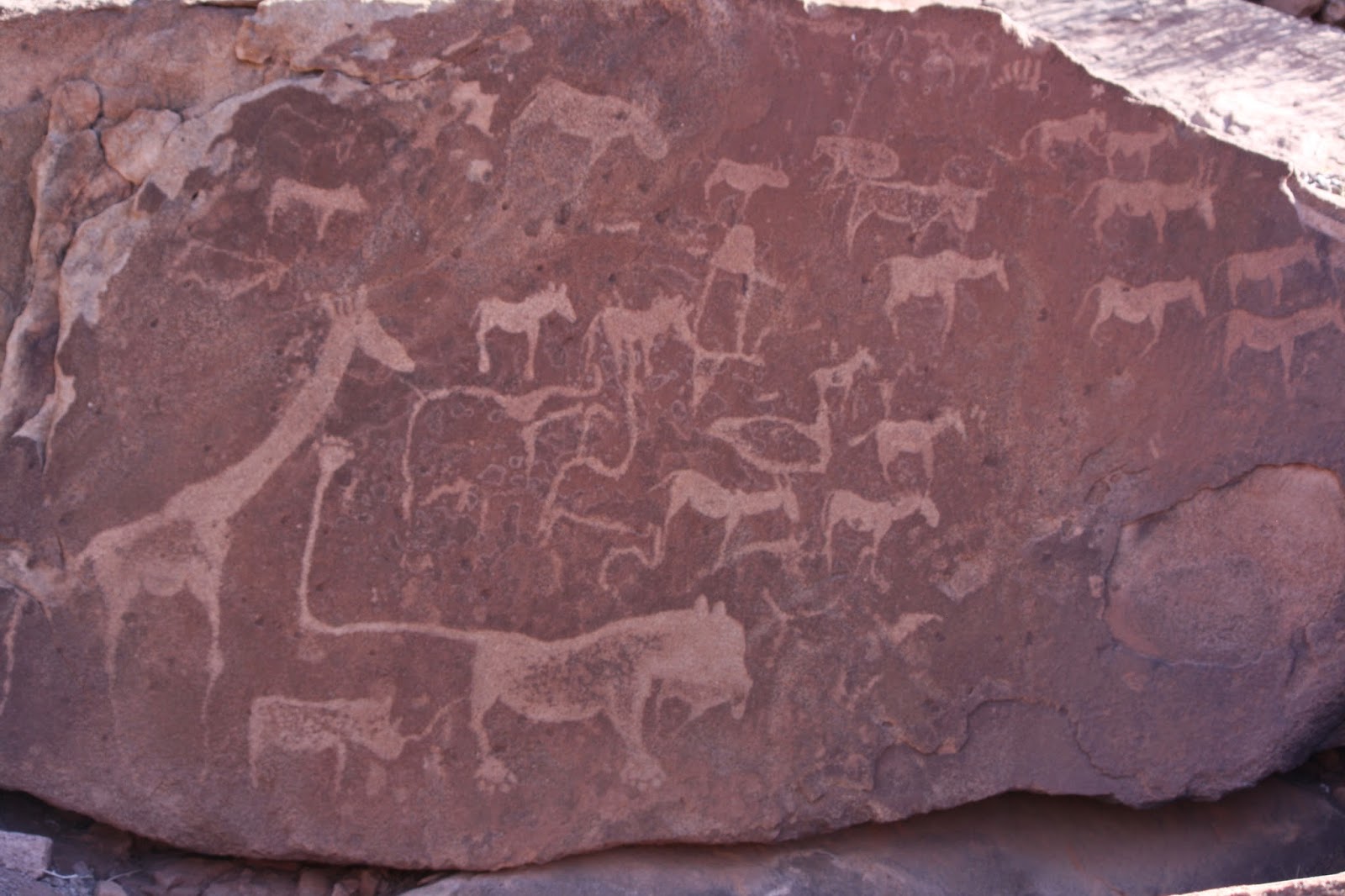During my trip to Namibia for New Year’s I was informed by
Team Chen, a friend of mine on the trip, that he was “The World’s Greatest
Explorer.” I doubted this, as did the
other two guys on the trip. But Team
kept on about how he was the Greatest and in the end I have to admit that he
did point us in the right direction of a great find when he suggested we visit
the petroglyphs of Twyfelfontein.
 |
| Walking from the parking area to where the petroglyphs were carved. The Twyfelfontein area is barren and arid. The Skeleton Coast is less than 75 miles from where we were, but that didn't help. Rain hadn't fallen in the area in over three years at the time of our visit. |
Lying some hundred and twenty kilometers or so from
Namibia’s infamous skeleton coast is a place called Twyfelfontein, which in
Afrikaans means the “Doubtful Fountain.”
It was so named this because the original European settler in this area
would always remark that he was doubtful the local spring would produce much
water that year. Sure enough it didn’t
and he had a pretty dreadful time making a living there.
 |
| The original white settler's home... or at least what remains of it. |
He wasn’t the first inhabitant of that area - far from it
actually. Long before him, and even now,
there are a lot of indigenous groups calling the Doubtful Fountain their
home. While living there they created
timeless works of art, which were the reasons for us even wanting to drive out
there in the first place.
 |
| A couple of giraffe and a rhino were etched between two to five thousand years ago on this panel. |
Led by Team’s notion that this is something worth seeing and fueled by his desire to see “every UNESCO world heritage site on the planet…
there’s only a few thousand” we exited the car and hired a guide named
Sylvia. During our hike with Sylvia we
saw seven panels of petroglyphs that ranged from two to five thousand years
old. As it turns out the petroglyphs
were used as an indicator from one passing hunter to another of what prey had
been seen in the area at one time or another.
This caused some confusion for me because I wondered aloud, “Well, if
they’re so old how was a hunter able to tell the difference between what was
there 1,000 years ago compared to just 10 years ago?”
 |
| Sylvia being a boss and breaking down petroglyphs for the four of us. One of the best guides I've ever had on a tour - anywhere. |
Sylvia was on it! She
said the hunters were so experienced that they would’ve been able to tell the
difference between the newer carvings versus the older ones. The carvings themselves were amazing: rhinos,
lions, elephants, giraffes, human footprints, and even seals were carved by
hunters from long ago. (Seals can be
found on Namibia’s Skeleton Coast some 100+ kilometers away).
 |
| Here is a very old giraffe carving with human footprint carvings flanking the two sides of its neck. |
As it turns out, during our time in Namibia the four of us visited
the only two world heritage sites in the country (the other being the Namib Sand Sea), which puts Team (and the
other three of us for that matter) on the right track of visiting all the
really important sites that give human existence on this planet some meaning
and context.
 |
| Team "The World's Greatest Explorer" Chen on the left, Jacob Johnson sitting on the UNESCO Heritage Site Marker, Caleb Rudow looking too cool for school on the right, and myself made up this Namibia expeditionary group. |
Additional Pictures of the Petroglyphs at Twyfelfontein:
 |
| This petroglyph panel features a lion, multiple giraffe, wildebeest, hartebeest, and other animals found in the area. |
 |
| Us (Caleb, Jacob, Team, and I) with two German girls that we basically stalked through Namibia. Everywhere they went we would show up about a day later and camp right next to them (we did not intend for this). They were good sports about it. And on this day we bumped into them right there at the petroglyphs. |
 |
| A blue wildebeest carved into a stone face. |
 |
| A giraffe carved into the rock. |










No comments:
Post a Comment